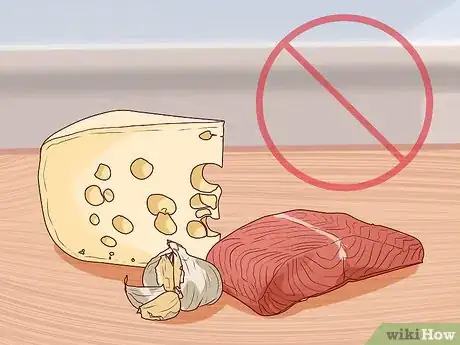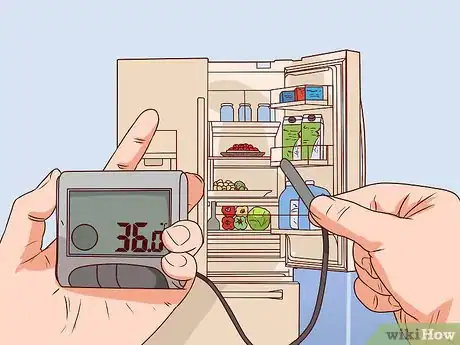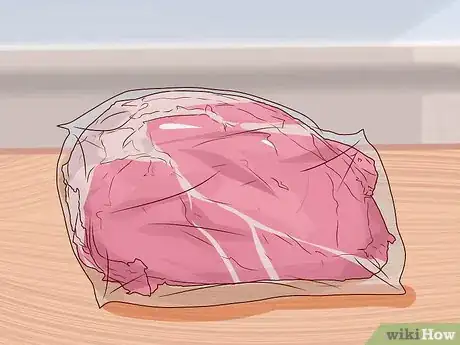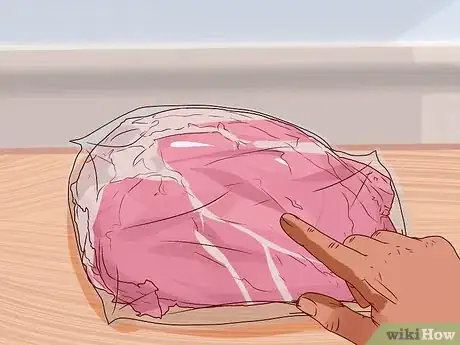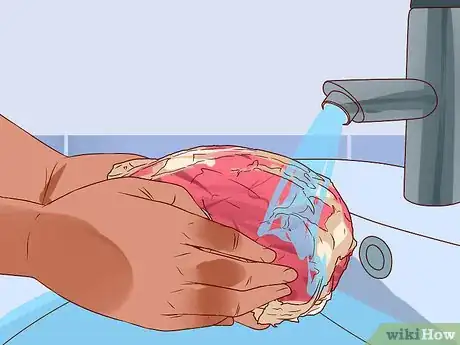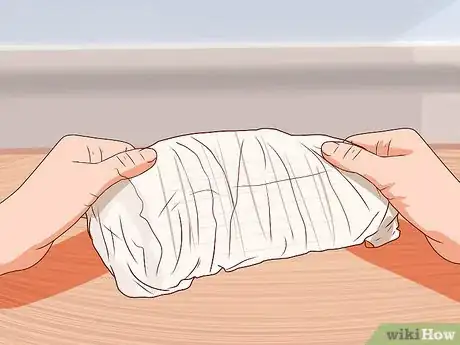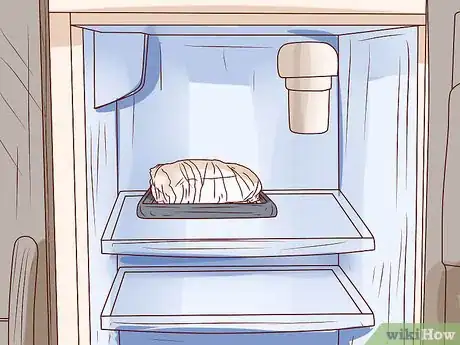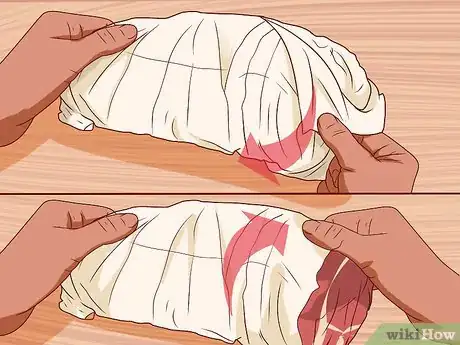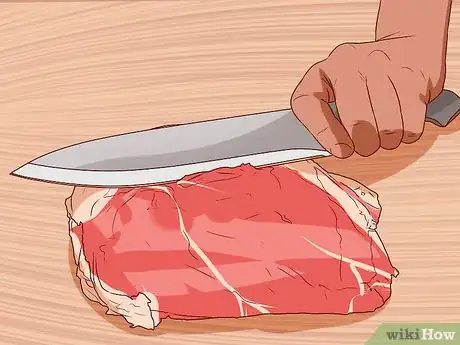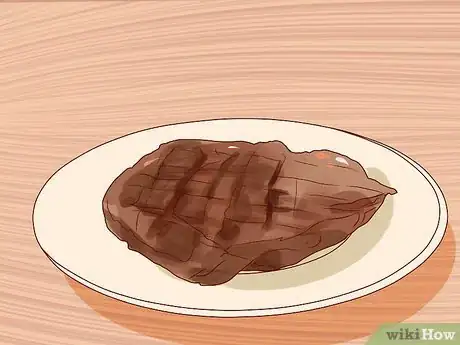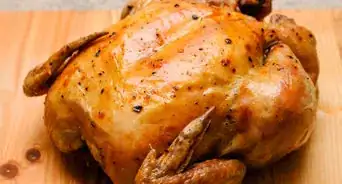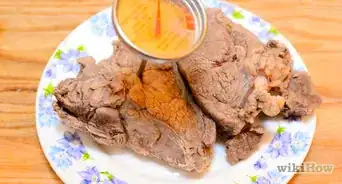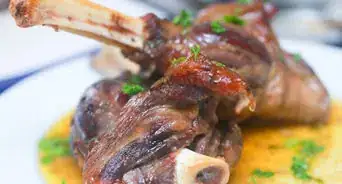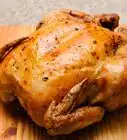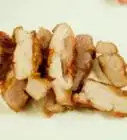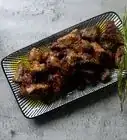This article was co-authored by wikiHow Staff. Our trained team of editors and researchers validate articles for accuracy and comprehensiveness. wikiHow's Content Management Team carefully monitors the work from our editorial staff to ensure that each article is backed by trusted research and meets our high quality standards.
wikiHow marks an article as reader-approved once it receives enough positive feedback. In this case, 92% of readers who voted found the article helpful, earning it our reader-approved status.
This article has been viewed 183,518 times.
Learn more...
Aging beef increases the tenderness and taste of the meat by producing a more succulent, beefier flavor. Most beef is aged in shrink wrap in a process called wet aging. However, exposing meat to the air will cause water to evaporate from it, concentrating its flavor. This is called dry aging. Dry aging can take anywhere from two to three weeks depending on the type and cut of the meat, as well as the desired end flavor and tenderness.[1]
Steps
Readying Your Freezer for Dry Aging
-
1Designate a separate dry aging refrigerator or freezer. To dry age your meat safely and properly, you'll need to take steps to limit changes in temperature and humidity. It is especially important to keep your meat at the right temperature during the aging process. Designating a separate dry aging refrigerator or freezer is the easiest way of doing this.
- Meat will spoil above 40°F (4°C) but will freeze below 32°F (0°C). The ideal temperature for aging is 36°F (2.2°C) throughout the entire aging process.[2]
- Using your everyday refrigerator is not recommended. The more you open and close your refrigerator/freezer, the more the temperature and humidity will change.
- You might use a small, temperature adjustable "dorm" refrigerator or a storage freezer for your dry aging.[3]
-
2Clean your refrigerator of possible contaminants. Meats will absorb other strong flavors and odors. Items like cheese, fish, and garlic will likely influence the taste of your meat while it ages. A thorough cleaning before dry aging will help protect the natural flavor profile of your meat.
- The best way to ensure that there are no subtle contaminants in your refrigerator/freezer is to defrost and clean your freezer with a suitable general purpose cleaner.
- If smells linger after cleaning, sprinkle a layer of baking soda on the inner surfaces of your refrigerator/freezer and thoroughly wipe it with a rag.
Advertisement -
3Verify the temperature in your refrigerator/freezer. Home refrigerators and freezers sometimes do not have as fine an internal thermometer as commercial grade ones. In some cases, your refrigerator might not have an internal temperature gauge, and you'll need to buy one so you ensure a consistent temperature throughout the aging process.
- A normal thermometer might not stand up to the cold temperatures as well as a specifically intended cold temperature/freezer thermometer. These will likely be available at your local hardware store.
- You might want to choose a thermometer that has a humidity gauge, as well. For consistent results, a humidity of 60% should be maintained, though many at home dry-agers have found a wider range has little effect on the end product.[4]
-
4Add a fan for improved circulation. Air circulation is important for the dry aging process. Limited circulation can lead to your meat failing to dehydrate at the optimal level. Adding a small desk fan to the inside of your meat refrigerator/freezer can solve this problem.
- You may need to cut a notch in the seal of your refrigerator/freezer for the cord of the fan. After fitting the cord into the notch, you may want to pack any open gaps with some kind of insulation.[5]
Selecting and Preparing the Meat
-
1Choose a high quality, large cut of meat. You'll also want your meat to be a kind that uses quick cooking methods, like New York strips, rib steak, and porterhouse cuts. Small cuts of meat should be avoided, as the loss of moisture during aging can make these seem too small to be the main course of a meal. Larger pieces, on the other hand, can be trimmed down.
- Individually cut steaks will not work for the dry aging process. You'll need a whole cut, like rib sections 103, 107, 109A, and 109 Export.
- Boneless beef rib or loin roast rated as "choice" or "prime" are also good options for your dry aging.[6]
- When buying one of these cuts from a butcher, you should ask him not to trim your cut of meat at all.
- Do not trim your meat before storing it for dry aging.[7]
-
2Examine the color of the meat prior to storing. The color is directly related to the tenderness of the beef and how long the aging process should last. If your beef is darker, it does not need to be aged more than a week. Beef that is lighter in color should be aged more than 7 days, but no longer than 30 days.[8]
- If you have difficulty discerning the color of your meat at a glance, you might want to compare it side by side with a fresh cut of meat.
-
3Unwrap and rinse the meat. Remove your meat from the packaging it came wrapped in. Then, with cool water, thoroughly rinse all parts of the meat exposed to the open air. After you have finished rinsing, pat the meat dry with paper towels. Once your meat is dry, it's ready to be wrapped.[9]
-
4Wrap your meat in cheesecloth. The cheesecloth will form a protective barrier around your meat and will prevent the meat from dehydrating too suddenly. Wrap your cut of meat loosely in the cheesecloth so that all exposed portions of it are covered by three layers of the cloth.
- You can also protect your meat from sudden dehydration with a triple thick layer of paper towel.[10]
Dry Aging Your Meat
-
1Place your beef in your refrigerator/freezer. You can place your meat directly onto a clean rack of your refrigerator/freezer, or you can first put your meat onto a suitable tray, like a rimmed baking sheet. Set your refrigerator fan to low, and double check the temperature to make sure it is at 36°F (2.2°C).[11]
-
2Rewrap your meat after the first day. As the meat ages, sometimes your covering can get stuck to the meat, leaving fibers behind. After the first day, remove your cheesecloth or paper towel covering, and then loosely rewrap the meat using the same covering.
- As your paper cheesecloth/paper towel will have already absorbed some moisture from the meat, it'll be less likely to leave fibers behind when the aging process is finished.[12]
-
3Allow your meat to age for the designated time. You'll want to dry age your meat for the length of time you determined it would need from its coloring. You may not notice a difference in your meat when aging it for periods of time shorter than two weeks.[13]
- It's common for your meat to start developing an unpleasant smell during the aging process. This could affect other meat in your fridge, which is another reason why it's good to use a separate, designated fridge/freezer for aging.[14]
-
4Shave off the dry exterior. The outer parts of the meat will be the most dehydrated. These parts won't likely be edible, but under this crusty surface you'll find the tender, flavorful meat that aged beef is known for. Use a sharp knife to shave free the outer layer.[15]
- If you notice any fat that has dried, shave this from your meat as well. Good fat that still looks moist, however, should be kept.
-
5Consume the beef soon after aging. Now that the aging is complete, you can cut your meat into portions, like steaks. Shortly after that, your meat should be eaten to prevent an unhealthy amount of post-aging breakdown.
- If you are unable to eat the meat the day it is done aging, you can leave it in a refrigerator for 1 to 2 days without damaging the meat.[16]
Community Q&A
-
QuestionI am very confused. There are expiry dates on meat that we buy, and other websites proclaim it must be used within 2 day of that date. Do we just ignore that use-by date?
 jaka kovačCommunity AnswerIf you store it under 5° C it won't spoil, though I would choose meat from a local butcher. If you are still worried you can try aging in oil, but the oil breaks down and dissolves proteins.
jaka kovačCommunity AnswerIf you store it under 5° C it won't spoil, though I would choose meat from a local butcher. If you are still worried you can try aging in oil, but the oil breaks down and dissolves proteins. -
QuestionI am watching some aging meat while the owners are away. The sealed bag has ballooned. Is this normal?
 Community AnswerWhen using a dry aging bag, depending on the manufacturer, your bag may or may not inflate. Most are supposed to have an air tight seal that allows moisture in prevents excess air exposure. You'll have to follow the instructions that came with your dry aging bag to discern whether this is natural for your bag or not.
Community AnswerWhen using a dry aging bag, depending on the manufacturer, your bag may or may not inflate. Most are supposed to have an air tight seal that allows moisture in prevents excess air exposure. You'll have to follow the instructions that came with your dry aging bag to discern whether this is natural for your bag or not. -
QuestionDo I cook the meat after aging it?
 Community AnswerUnless you are making a tar-tar steak, you should cook the steak after aging it if you plan to eat it.
Community AnswerUnless you are making a tar-tar steak, you should cook the steak after aging it if you plan to eat it.
Warnings
- Do not move or disturb the aging process, if possible, until you are ready to consume.⧼thumbs_response⧽
- Failing to properly clean your refrigerator before aging can result in the growth of bacteria that can ruin your meat or contaminate it.⧼thumbs_response⧽
Things You'll Need
- Whole, untrimmed cut of meat
- Designated aging refrigerator/freezer
- Desk fan (optional; recommended)
- Cheesecloth (or paper towels)
References
- ↑ http://www.seriouseats.com/2013/03/the-food-lab-complete-guide-to-dry-aging-beef-at-home.html
- ↑ http://www.beefresearch.org/CMDocs/BeefResearch/Dry%20Aging%20of%20Beef.pdf
- ↑ http://www.epicurious.com/expert-advice/dry-age-steak-at-home-article
- ↑ http://www.epicurious.com/expert-advice/dry-age-steak-at-home-article
- ↑ http://www.seriouseats.com/2013/03/the-food-lab-complete-guide-to-dry-aging-beef-at-home.html
- ↑ http://www.finecooking.com/articles/dry-aging-beef-pays-off-big-flavor.aspx
- ↑ http://www.seriouseats.com/2013/01/the-food-lab-dry-age-beef-at-home.html
- ↑ http://www.seriouseats.com/2013/03/the-food-lab-complete-guide-to-dry-aging-beef-at-home.html
- ↑ http://www.finecooking.com/articles/dry-aging-beef-pays-off-big-flavor.aspx
- ↑ http://www.finecooking.com/articles/dry-aging-beef-pays-off-big-flavor.aspx
- ↑ http://www.seriouseats.com/2013/03/the-food-lab-complete-guide-to-dry-aging-beef-at-home.html
- ↑ http://www.finecooking.com/articles/dry-aging-beef-pays-off-big-flavor.aspx
- ↑ http://www.finecooking.com/articles/dry-aging-beef-pays-off-big-flavor.aspx?pg=0
- ↑ http://www.seriouseats.com/2013/03/the-food-lab-complete-guide-to-dry-aging-beef-at-home.html
- ↑ http://www.finecooking.com/articles/dry-aging-beef-pays-off-big-flavor.aspx
- ↑ http://www.beefresearch.org/CMDocs/BeefResearch/Dry%20Aging%20of%20Beef.pdf
- ↑ http://www.seriouseats.com/2013/03/the-food-lab-complete-guide-to-dry-aging-beef-at-home.html
About This Article
To age beef, start by unwrapping the meat and rinsing it with cold water. Then, wrap the beef in a cheesecloth, which will protect it from drying out. Place the wrapped beef in your fridge and check that the temperature in there is around 36 °F, which is ideal for aging beef. Keep the beef in your fridge for at least 2 weeks so it has time to age properly. After at least 2 weeks, take the beef out of the fridge, cut the dry outer part of the meat off, and enjoy! For more tips, including how to choose the best meat to dry age, read on!

